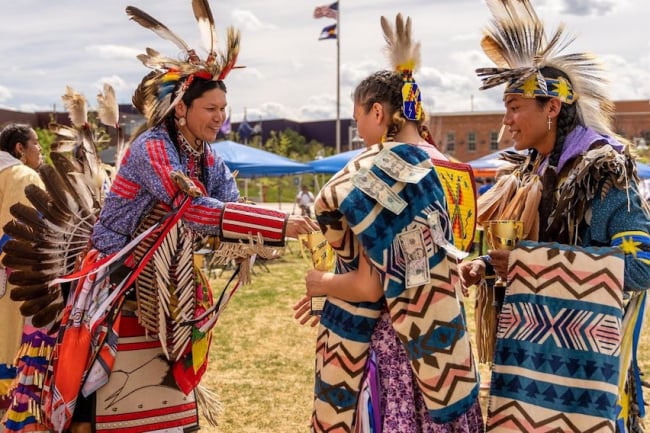You have /5 articles left.
Sign up for a free account or log in.

Metropolitan State University of Denver hosts a powwow for Indigenous students and community members.
Josh Geurink
Kyla Aguirre, a junior at Metropolitan State University of Denver, didn’t know if she could afford her last year of college. She’s a full-time student, and she and her husband were struggling to get by on just one income. But she recently found out that she—and all Native American students at the institution—will have their tuition and fees covered from now on, starting next fall.
She described the news as “life-changing” for her and her peers. The new grant program will cover all tuition costs not covered by state or federal financial aid for Colorado residents belonging to federally recognized tribal nations. It will also waive tuition for students from other states who are members of tribes historically based in Colorado.
“Indigenous people were forced to give up their land, their children and their lives, all for broken promises,” said Aguirre, a political science major who is a member of the Chickasaw Nation and vice president of the university’s Native and Indigenous Student Alliance. “They tried to steal our future, so this is the first step in a long walk to correcting the past.”
Similar tuition waiver programs focused on Native American students are cropping up across the country ahead of the fall semester. These initiatives come after Indigenous communities nationwide faced staggering COVID-19 infection rates and deaths and related financial losses during the pandemic—all of which exposed the stark economic difficulties and disparities in health care and education faced by tribal communities and aggravated by the pandemic.
Will Simpkins, vice president of student affairs at MSU Denver, said the university averages 70 to 100 Native American students annually. There were 91 Indigenous students in fall 2020, making up 0.5 percent of the student body, according to data from the university. He hopes the new program helps with “recapturing students who may have stopped out over the pandemic” and increasing the number of Native American students enrolled. The program is expected to cost roughly $200,000 in its first year.
“This is the university saying, ‘This is the right thing to do,’ and there’s a direct cost to doing the right thing,” he said. “It’s an investment in our students and our communities.”
University of California System president Michael Drake announced in April that all California residents belonging to federally recognized tribes can pursue undergraduate or graduate degrees in the UC system with tuition fully covered. The initiative, which is expected to cost $2.4 million, launches next fall. Funding will also be available to students from tribes that are not federally recognized but will be provided through private scholarship funds, because the university system is prohibited by state law from providing financial aid based on race or ethnicity; it can offer aid to members of other countries or sovereign nations, however.
The program will “advance critical efforts to expand student diversity and make the University of California more affordable and accessible for California’s Native American undergraduate and graduate students,” Drake wrote in a letter to campus chancellors. “The University of California is committed to recognizing and acknowledging historical wrongs endured by Native Americans.”
State lawmakers also appear to be paying renewed attention to financial barriers experienced by Native American students. A recent Colorado law granted in-state tuition to Native American students from tribes historically rooted in the state, regardless of whether they were Colorado residents. Oregon also launched a new grant program, proposed by Governor Kate Brown, for the 2022–23 academic year. The program covers tuition, housing and books at public institutions for undergraduate and graduate students belonging to Oregon’s nine federally recognized tribes after they apply for federal or state financial aid. Grants can also be used to pay tuition at some local private universities up to the amount of the average cost of attendance at Oregon public universities.
“For far too long, due to disparities caused by systemic barriers, too few tribal students have had access to postsecondary education,” Brown said in a press release. “This grant program is a remarkable step forward that will serve as a model for the rest of the nation, help to right historic wrongs, and profoundly impact the future of Oregon’s tribal students and our dynamic tribal communities.”
The grant program “removes one of the most serious barriers to college success for a population that has been deeply underserved,” Juan Báez-Arévalo, director of the Office of Student Access and Completion at the Oregon Higher Education Coordinating Commission, said in the release. “We are honored to work in consultation with Oregon tribes to build equitable college opportunity and support the talents and promising futures of tribal students, their families, and communities.”
Native American leaders and scholars say the high costs of college have been a long-standing hurdle for Native American students, who disproportionately come from low-income households.
U.S. Census Bureau data found that American Indian and Alaska Native populations have the highest poverty rate of any racial or ethnic group in the country, with 23 percent of those Americans living below the national poverty line in 2019. Only 24 percent of American Indians and Alaska Natives ages 18 through 24 were enrolled in college that year, compared to 41 percent of other Americans in that age group. Only a quarter of Native Americans over the age of 25 held an associate degree or higher in 2019, while 42 percent of non-Native Americans in that age group over all held degrees, according to the Postsecondary National Policy Institute.
Carrie Billy, president and CEO of the American Indian Higher Education Consortium, said a recent survey of students at tribal colleges found that the “No. 1 factor that causes students to drop out of college, not go to college or think about leaving college is financial concerns.” She noted that tribal colleges intentionally keep tuition costs low because almost 80 percent of students are eligible for the Pell Grant, federal financial aid for low-income students—yet students still struggle to pay.
Some institutions established Native American tuition waiver programs that predate the recent wave. Fort Lewis College in Colorado and the University of Minnesota at Morris, for example, were historically Native American boarding schools. The federal government stipulated that both institutions be made free for Native American students in the early 1900s.
Majel Boxer, chair and associate professor of Native American and Indigenous studies at Fort Lewis College, said there’s growing momentum to cut college costs for Native American students. She believes the Truth and Reconciliation Commission in Canada, which addressed the country’s controversial Indian Residential Schools system, helped jump-start a social reckoning in North America with how educational institutions historically failed Native American students. U.S. Secretary of the Interior Deb Haaland, the first Native American in the position, announced a similar initiative last year to examine the troubling history of federal boarding schools.
Tuition waivers are also a response to advocacy from politically active tribe members, Billy said. American Indian college enrollment and graduation rates remain low, but they’ve increased over the last decade, and as more tribe members earn degrees, she sees more Native graduates going into local and state politics and calling for more affordable education for their communities. The percentage of Native Americans who earned an associate degree or higher increased from 21 percent to 25 percent from 2010 to 2019, according to the Postsecondary National Policy Institute. She also views tuition waivers for American Indian students as a product of the racial reckoning that followed the killing of George Floyd.
Policy makers and campus leaders “have a greater awareness of American Indians, people of color and the invisibility of them in the past and the lack of intention,” she said.
The trend could also be an outgrowth of the land acknowledgment movement in higher ed, said Simpkins of MSU Denver. University leaders have grown accustomed to recognizing tribes that previously occupied the land on which their campuses sit, but college officials and Native American faculty members are starting to ask themselves what “action” should follow the land acknowledgment statements.
“The land acknowledgment that we do at most of our large events is a critical aspect of honoring the past,” Simpkins said. “This is an investment in the future. This is an action we can take.”
However, he noted that the details of grant programs focused on Native American students need ironing out over time and need to be carefully designed with input from tribal leaders. For example, he’s trying to figure out how the university can offer support to Native American students who aren’t yet official members of their tribes and need to apply for membership after a student told him how complex that process can be.
Billy said policy makers who are proposing state financial aid programs for Native American students should make sure tribal colleges are included among the institutions American Indian students can attend for free—and also ensure these institutions can afford to participate. Tribal college presidents in Michigan have told her that the state’s tuition waiver program for Native American students requires colleges to partly foot the bill, an expensive venture at underresourced institutions where most students qualify for the waivers.
“They’re committed to serving their students and helping their students,” so if programs aren’t fully funded by the state or other sources, tribal colleges “just absorb that loss,” she said.
Aguirre is hopeful about the potential long-term ripple effects of MSU Denver’s program. She’s not only excited about what the program will do for her but what it could do for her family. She said two of her sisters are now considering attending the institution because of its grant program.
“They immediately are talking about making arrangements to come here for school,” she said. “So, it’s definitely already making an impact.”





